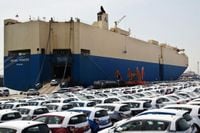As President Donald Trump’s trade war escalates, American automakers are bracing for significant financial impacts, particularly General Motors (GM) and Ford Motor Co. Both companies are facing hefty tariffs on imported vehicles, leading to revised earnings forecasts and strategic shifts in production.
Trump has imposed a 25% tariff on imported automobiles, claiming it is a necessary response to the unfair barriers that American-made cars encounter abroad. However, this move has left GM scrambling to manage potential levies of up to $5 billion this year. According to GM’s estimates, this tariff will slash their earnings before interest and taxes (EBIT) by approximately 20% in 2025.
Ford, similarly affected, announced on May 5, 2025, that it anticipates a $2.5 billion hit due to the tariffs. The automaker plans to mitigate this impact through $1 billion in cost savings. Erik Gordon, a professor at the University of Michigan's Ross School of Business, highlighted the changing landscape of car manufacturing, stating, "It used to be that when you bought a Toyota, it was made in Japan and when you bought a Chevy, it was made here in the US. Now, some Toyotas are made in Japan and some are made in the US. And if you buy a Chevy, it might have been made overseas."
In an updated guidance for 2025, GM now expects a hit of $4-5 billion due to these tariffs. Initially, the company projected an EBIT range of $13.7-15.7 billion, but this has been revised down to $10.0-12.5 billion. This adjustment follows executive actions taken on April 29, which aim to offset tariffs based on domestic production and eliminate the risk of tariff stacking. Under the new plan, automakers will be reimbursed for tariffs already paid since the 25% car tariff went into effect, along with a reimbursement for imported parts up to 3.75% of the value of a U.S.-made vehicle, decreasing to 2.5% next year.
Despite these challenges, GM remains optimistic about maintaining profitability in 2025. CEO Mary Barra stated, "We believe the president’s leadership is helping level the playing field for companies like GM and allowing us to invest even more in the U.S. economy." The automaker plans to offset at least 30% of its tariff exposure by increasing U.S. production, particularly at its Fort Wayne plant in Indiana, where truck production is set to rise by 20%. GM also anticipates that vehicle pricing will remain relatively stable, with a projected increase of only 0.5-1% year over year.
However, the tariffs pose a significant threat to the affordability of vehicles. Jeff Schuster, a former vice president of research at GlobalData, predicts that car makers selling in the U.S. may cease building 1.5 million lower-priced vehicles due to these tariffs. This situation exacerbates an auto affordability crisis, as the average price of a new car in the U.S. now exceeds $48,000, a 21% increase from five years ago. Schuster noted, "It does take away the entry market and obviously hurts those buyers that are in that space."
As GM navigates these turbulent waters, it remains committed to its operations in South Korea, which serve as a vital production hub for budget cars. GM’s Korean operations are crucial for producing models like the Chevrolet Trailblazer and the Buick Encore GX. Despite the looming tariffs, GM plans to maintain its production base in Korea, with CFO Paul Jacobson emphasizing the company’s strategy to reduce costs rather than raise vehicle prices.
Industry insiders suggest that GM is closely monitoring trade negotiations between the U.S. and South Korea, which could significantly impact its global manufacturing strategy. U.S. trade representative Jamieson Greer is scheduled to visit Korea for the APEC Trade Ministers’ Meeting, where discussions about reciprocal tariffs will take place. Lee Ho-geun, a car engineering professor at Daeduk University, pointed out that GM’s reliance on cost-effective production in Korea is essential for manufacturing economically priced vehicles. He cautioned that if trade talks fail and tariffs remain high, GM may have to reconsider its operations in Korea.
Yoon Myong-ok, GM Korea’s chief marketing officer, recently announced that the Bupyeong plant received an additional order of 21,000 units from U.S. headquarters, raising its projected production volume from 208,000 to approximately 230,000 units. In 2024, 84.8% of GM Korea’s production was exported to the U.S., highlighting the importance of this facility for the automaker’s North American operations.
As the automotive industry grapples with the repercussions of these tariffs, the future remains uncertain. Automakers are caught in a precarious position, balancing the need to remain competitive with the challenges posed by the tariffs. With the average price of new vehicles continuing to rise, consumers may soon feel the pinch as automakers adjust to the new economic landscape. The coming months will be crucial as GM, Ford, and other automakers strategize to navigate the ongoing trade tensions and the evolving market dynamics.





